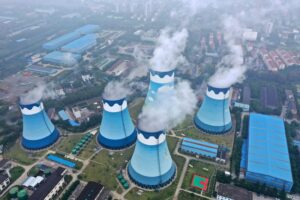On a humid day in February, a small group of workers huddled in front of a large solar panel factory inside Thailand’s biggest manufacturing hub in the eastern coastal province of Chonburi, home to some of the world’s top solar panel-producing companies.
The men and women, mostly in their twenties, all hoped to land a job on a production line assembling solar cells into panels destined for export.
They knew they may not hold the job for very long after reading complaints of former employees on social media about work being regularly cut when orders were low.
But the company promised fair pay and, needing work, they were willing to take the risk.
That risk is growing, as Thailand’s solar industry has become caught in an escalating trade war between the US and China, with Thai solar workers paying the price.
Large Chinese companies dominate Thailand’s solar manufacturing industry, which produces solar cells and panels for export to the US market.
But as Washington erects trade barriers to protect its homegrown solar sector from a rising tide of cheap Chinese imports, Thailand’s industry is being squeezed.
Solar manufacturers in Southeast Asia’s second-largest economy that rely heavily on Chinese components are now facing nearly 400% tariffs to export their products to the US.
Analysts say the tariffs threaten to hurt Thailand’s manufacturing sector and its workers, and could have a knock-on impact on solar rollout in the country. But the changing trade landscape also creates an opportunity for producers to find new markets, including by accelerating solar deployment and the energy transition across the Southeast Asian region.
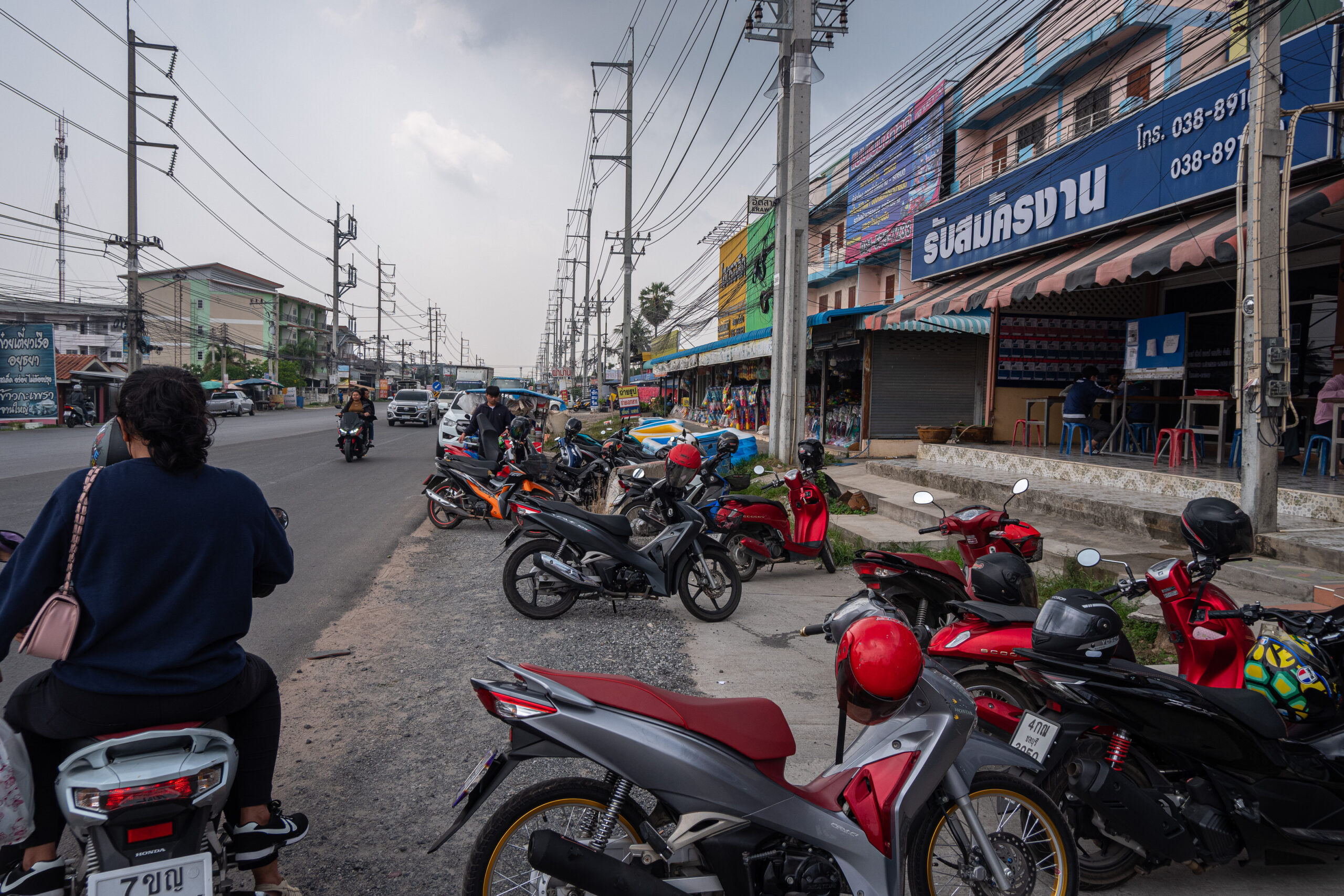

The heat of the solar trade war
For more than a decade, the US has waged a tariff war on growing imports of cheap Chinese solar panels, which it says harm its domestic industry.
China’s mass production of solar cells and modules has enabled the expansion of clean energy globally. The cost of solar panels has declined by 90% in the past decade. But China’s subsidised and cut-price solar production has also led to accusations of unfair trade practices.
In response, Chinese manufacturers relocated the final production stages to neighbouring Asian countries in an attempt to avoid the US import tax, turning Southeast Asia into a major solar-panel assembly hub and export base.
As Chinese exports of solar components to Vietnam, Thailand, Malaysia and Cambodia boomed, so did US imports of Southeast Asian solar panels.
By 2023, 80% of US solar module imports came from those four countries. Nearly a quarter came from Thailand alone.
But in recent months, several Chinese manufacturers with factories in Southeast Asia suspended some of their operations in the region, after the US announced a string of antidumping duties on solar imports from the four countries in a bid to close the loophole.
Thousands working in Thailand’s solar factories – most of whom had left the agricultural north of the county to seek better-paid employment in an industry which promised decent jobs – were put on leave or suddenly dismissed.
Climate Home News analysed local media reports and social media posts relating to worker dismissals at three leading solar manufacturers with factories in the Eastern Economic Corridor, the country’s largest manufacturing zone: Chinese companies Runergy and Trina Solar, one of the world’s largest solar PV manufacturing firms, and Canadian Solar, which has long conducted most of its manufacturing operations in China.
We found that close to 8,000 full-time staff and subcontracted workers were either temporarily or permanently dismissed in 2024. Over that time, US officials investigated a complaint from American manufacturers that companies with factories in Southeast Asia were dumping subsidised and unfairly cheap products on the US market.
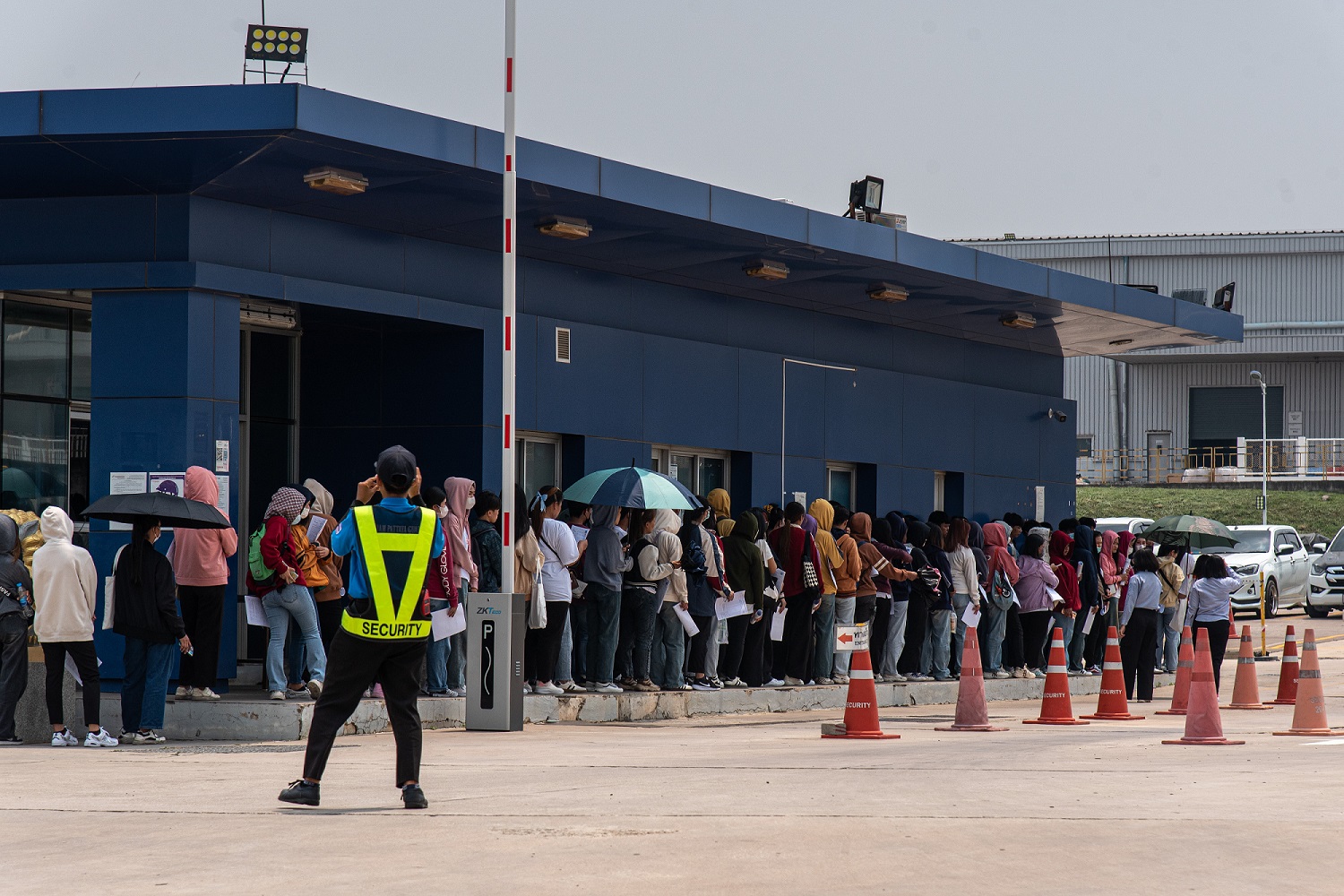

An industry losing its grip on its biggest export market
Last month, US trade officials unveiled hefty tariffs of at least 375% on imports of solar cells from Thailand.
The US International Trade Commission, a bi-partisan government agency, is due to make a final decision about the tariffs in June. In private, analysts say they are likely to be approved.
The Institute for Energy Economics and Financial Analysis (IEEFA) recently found that any price increases beyond 250% would make most Southeast Asian imports “untenable”.
“Any company in any country where the combined tariffs is greater than 250% will likely see their orders decline or get cancelled,” Grant Hauber, of IEEFA, told Climate Home.
Over the past year, US officials’ tariff deliberations rocked Thailand’s solar industry.
“There has been a broad suspension of operations among Chinese companies in Southeast Asia, including Thailand, with many closures likely to be permanent,” said Linxiao Zhu, a research fellow at the Oxford Institute for Energy Studies.
“The region risks losing a significant share of its solar manufacturing capacity due to the loss of access to the US market.”
“Thailand’s solar manufacturing industry faces some serious challenges,” agreed Forbes Chanthorn, BloombergNEF’s Thailand energy transition analyst based in Singapore. “It is losing its grip on some of its biggest export markets without any short-term alternatives in sight.”
And the situation could go from bad to worse as US President Donald Trump threatens an additional 37% import tariff on all goods from Thailand – one of the highest rates in Washington’s planned universal tariff onslaught, now paused until June. If applied, this would push the tariffs on Thailand’s solar cells up to 426%.
In an interview, Charuwan Phipatana-Phuttapanta, a solar expert at Thailand’s energy ministry, acknowledged that the tariffs will impact employment in the country’s solar industry.
Workers fall victim to tariffs
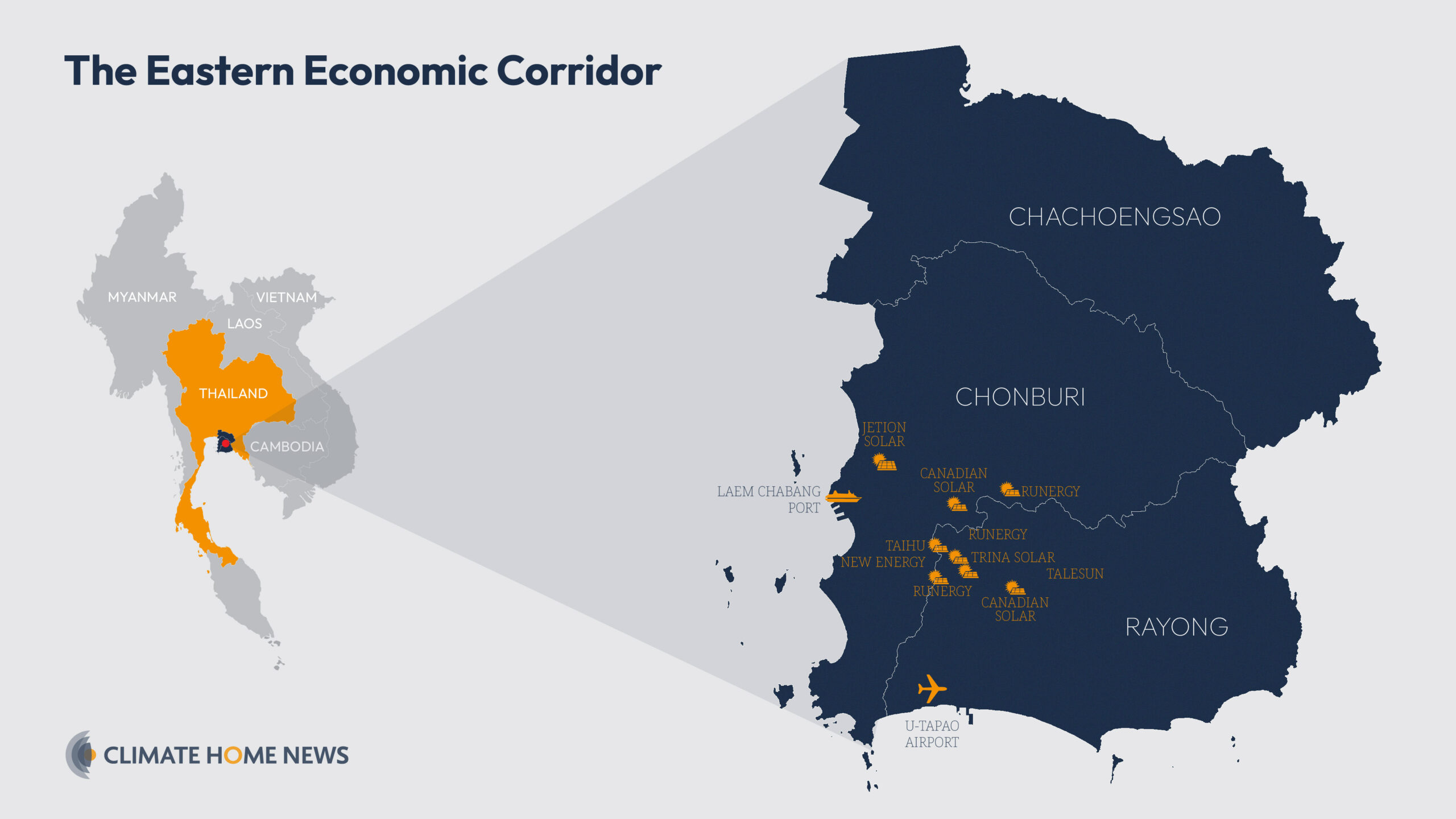

Spanning three provinces on Thailand’s eastern coast, the Eastern Economic Corridor (EEC) is key to the government’s plan to transform the area into an economic powerhouse.
Enticed by generous tax breaks and cheap labour, international companies have flocked here to manufacture everything from air conditioners to batteries for electric vehicles and solar panels for the regional and global markets.
Several leading Chinese solar manufacturing companies set up shop in the EEC nearly a decade ago. Soon, Thailand’s solar exports to the US soared.
But in June 2024, a two-year US tariff waiver on solar products from Southeast Asia – introduced by Joe Biden to boost solar deployment in the country – came to an end. Companies in the region importing silicon wafers from China to make solar cells for export to the US became subject to tariffs.
In the days that followed, several manufacturers slowed down or suspended operations, letting go of staff to adjust to the new tax regime, Amnuay Ngamnet, director of Rayong Labour Protection and Welfare office, the labour ministry’s local representative, told Climate Home.
In Rayong alone, the most southern of the EEC’s three provinces, 3,200 full-time workers at five solar factories were put on leave between 2022-2024, according to official data.
Videos posted on TikTok in recent weeks show deserted parking lots and unusually quiet grounds around some solar factories.
“No matter how good you are, if life stumbles, you cannot succeed. Goodbye,” one solar worker posted on the social media platform with a photo of a dismissal letter.




Amnat (whose name has been changed because of concerns that speaking to the media might affect his job prospects) was among thousands affected.
Like many others, the 39-year-old left his hometown in the agricultural northeastern region in 2022 to find a better-paid job at a solar plant in the EEC.
“It seemed like a promising industry. I hoped to spend years there,” Amnat told Climate Home over the phone. “But it didn’t turn out that way.”
Amnat worked as a subcontractor at a few Chinese solar factories, eventually landing a staff position at Runergy, which manufactures solar cells and modules.
He worked six days a week and earned approximately 25,000 baht ($745) a month, way above the average income for unskilled workers.
But in October 2024, he was dismissed along with “almost all of the employees” at the factory, according to local media reports. Amnat told Climate Home the retrenchment affected nearly 3,000 workers.
Runergy did not respond to repeated requests for comment.
The same month, Runergy opened its first module manufacturing plant in the US to keep supplying the American market – one of a number of solar companies hoping to benefit from tax credits under the Inflation Reduction Act (IRA).
As a permanent employee, Amnat was compensated 75% of his monthly wage, a lifeline during the three months it took him to find another job. But others were not so lucky.
Thousands of workers hired as subcontractors and benefiting from fewer rights were left without work or pay overnight as companies suspended some of their operations.
At risk of labour rights violations
“After leaving the solar company, my girlfriend was left unemployed for two months. It was difficult for us,” a TikTok user who had complained about the dismissals on social media, told Climate Home. The subcontracting company employing her made her sign a dismissal letter, absolving it of paying the compensation she was entitled to, he explained.
Bunyuen Sukmai, a local labour lawyer and rights activist, told Climate Home “most workers are not aware that the practice violates their rights” despite being routinely deployed.


In the workers’ housing estate, a few kilometres outside the industrial zone, the offices of subcontracting firms are flanked by hair salons and restaurants. A steady stream of job-seekers fill in application forms and scan QR codes to follow job announcements on social media.
“Subcontractors are usually the first to be affected by industry changes. They usually receive lower benefits and are most at risk of having their rights violated,” said Sukmai. But legal cases over unfair dismissal are rare as few workers have the resources to go down the judicial route, he added.




A representative of Trina Solar in Thailand declined to respond to questions. Canadian Solar did not respond to Climate Home’s repeated requests for comment.
However, in a letter dated June 2024 and shared on social media, Canadian Solar said it had paused operations at one of its factories to make changes to its production line and improve machinery. “Due to the current economic conditions and trade competition, the company needs to adjust to the market situation and the direction of the domestic and international economy,” it said.
It added that it had “great confidence in the potential and economic conditions of Thailand” where it intended to continue operating.
In search of new markets
Some large Chinese panel-makers have already started setting up production lines in Indonesia and Laos, which are not currently affected by the US solar import duties.
The Middle East has also emerged as a growing destination for Chinese solar investments, including for the production of key solar components such as polysilicon ingots and wafers.
“These efforts are designed to forge a supply chain completely outside of China serving the Middle East, the US, and other markets that may be subject to tariff risks,” Zhu wrote in a recent report for The Oxford Institute for Energy Studies.


To continue operating in Thailand, analysts say large solar manufacturers will need to seek new export markets outside of the US.
In the short-term, exports could be redirected to the European Union and India. The Thai government is racing to finalise a free-trade deal with the EU, where demand growth for solar equipment may be stronger than in the US, Laura Schwartz, a senior Asia analyst at risk intelligence company Verisk Maplecroft, told Climate Home.
“However, over half of China’s solar cell and module exports already go to Europe, so Thai exports would face stiff competition,” said Schwartz. And Indian solar developers will have to use locally made solar cells in government projects from June 2026.
But the tariffs could also mark “a turning point” for Southeast Asia’s solar industry, which could focus on supplying emerging markets in Africa and South America, and urgently accelerate the region’s own solar deployment, said Christina Ng, director of the Energy Shift Institute, a think-tank focused on Asia’s energy transition.
Thailand is dependent on gas for electricity generation but the government has set out plans for 51% of its electricity to come from renewables by 2037, with most of the additional renewable power expected from solar. Only around 3% of Thailand’s electricity currently comes from solar.
Thai companies assembling solar modules in the country are already calling for more incentives to expand a homegrown supply chain.
Krit Pornpilailuck, CEO of Solar PPM, fears Chinese solar manufacturers that can’t export their goods to the US “will flood the Southeast Asian market and plunge the price” of modules.
To protect the industry, Pornpilailak wants to see more support for Thai manufacturers to produce solar cells and other upstream components domestically.
“Thailand has more than six million tonnes of solar-grade quartz reserves that could be used to produce polysilicon – the key ingredient to produce solar wafers,” said Phipatana-Phuttapanta, the government’s solar expert. Although developing the resources would require “technical expertise and high investment”, she added.
“This is a chance for [manufacturers] to move up the value chain – from being seen as mainly low-cost assemblers to becoming leaders in more advanced clean energy technologies,” said Ng. “If the region takes this moment seriously and diversifies, it won’t just weather the disruption; it will emerge more resilient and competitive.”
The post Solar squeeze: US tariffs threaten panel production and jobs in Thailand appeared first on Climate Home News.
Solar squeeze: US tariffs threaten panel production and jobs in Thailand
Climate Change
Factcheck: Trump’s climate report includes more than 100 false or misleading claims
A “critical assessment” report commissioned by the Trump administration to justify a rollback of US climate regulations contains at least 100 false or misleading statements, according to a Carbon Brief factcheck involving dozens of leading climate scientists.
The report – “A critical review of impacts of greenhouse gas emissions on the US climate” – was published by the US Department of Energy (DoE) on 23 July, just days before the government laid out plans to revoke a scientific finding used as the legal basis for emissions regulation.
The executive summary of the controversial report inaccurately claims that “CO2-induced warming might be less damaging economically than commonly believed”.
It also states misleadingly that “excessively aggressive [emissions] mitigation policies could prove more detrimental than beneficial”.
Compiled in just two months by five “independent” researchers hand-selected by the climate-sceptic US secretary of energy Chris Wright, the document has sparked fierce criticism from climate scientists, who have pointed to factual errors, misrepresentation of research, messy citations and the cherry-picking of data.
Experts have also noted the authors’ track record of promoting views at odds with the mainstream understanding of climate science.
Wright’s department claims the report – which is currently open to public comment as part of a 30-day review – underwent an “internal peer-review period amongst [the] DoE’s scientific research community”.
The report is designed to provide a scientific underpinning to one flank of the Trump administration’s plans to rescind a finding that serves as the legal prerequisite for federal emissions regulation. (The second flank is about legal authority to regulate emissions.)
The “endangerment finding” – enacted by the Obama administration in 2009 – states that six greenhouse gases are contributing to the net-negative impacts of climate change and, thus, put the public in danger.
In a press release on 29 July, the US Environmental Protection Agency said “updated studies and information” set out in the new report would “challenge the assumptions” of the 2009 finding.
Carbon Brief asked a wide range of climate scientists, including those cited in the “critical review” itself, to factcheck the report’s various claims and statements.
The post Factcheck: Trump’s climate report includes more than 100 false or misleading claims appeared first on Carbon Brief.
https://www.carbonbrief.org/factcheck-trumps-climate-report-includes-more-than-100-false-or-misleading-claims/
Climate Change
Cropped 13 August 2025: Fossil-fuelled bird decline; ‘Deadly’ wildfires; Empty nature fund
We handpick and explain the most important stories at the intersection of climate, land, food and nature over the past fortnight.
This is an online version of Carbon Brief’s fortnightly Cropped email newsletter. Subscribe for free here.
Key developments
‘Deadly’ wildfires
WINE BRAKE: France experienced its “largest wildfire in decades”, which scorched more than 16,000 hectares in the country’s southern Aude region, the Associated Press said. “Gusting winds” fanned the flames, Reuters reported, but local winemakers and mayors also “blam[ed] the loss of vineyards”, which can act as a “natural, moisture-filled brake against wildfires”, for the fire’s rapid spread. It added that thousands of hectares of vineyards were removed in Aude over the past year. Meanwhile, thousands of people were evacuated from “deadly” wildfires in Spain, the Guardian said, with blazes ongoing in other parts of Europe.
MAJOR FIRES: Canada is experiencing its second-worst wildfire season on record, CBC News reported. More than 7.3m hectares burned in 2025, “more than double the 10-year average for this time of year”, the broadcaster said. The past three fire seasons were “among the 10 worst on record”, CBC News added. Dr Mike Flannigan from Thompson Rivers University told the Guardian: “This is our new reality…The warmer it gets, the more fires we see.” Elsewhere, the UK is experiencing a record year for wildfires, with more than 40,000 hectares of land burned so far in 2025, according to Carbon Brief.
-
Sign up to Carbon Brief’s free “Cropped” email newsletter. A fortnightly digest of food, land and nature news and views. Sent to your inbox every other Wednesday.
WESTERN US: The US state of Colorado has recorded one of its largest wildfires in history in recent days, the Guardian said. The fire “charred” more than 43,300 hectares of land and led to the temporary evacuation of 179 inmates from a prison, the newspaper said. In California, a fire broke out “during a heatwave” and burned more than 2,000 hectares before it was contained, the Los Angeles Times reported. BBC News noted: “Wildfires have become more frequent in California, with experts citing climate change as a key factor. Hotter, drier conditions have made fire seasons longer and more destructive.”
FIRE FUNDING: “Worsening fires” in the Brazilian Amazon threaten new rainforest funding proposals due to be announced at the COP30 climate summit later this year, experts told Climate Home News. The new initiatives include the Tropical Forests Forever Facility, which the outlet said “aims to generate a flow of international investment to pay countries annually in proportion to their preserved tropical forests”. The outlet added: “If fires in the Amazon continue to worsen in the years to come, eligibility for funding could be jeopardised, Brazil’s environment ministry acknowledged.”
Farming impacts
OUT OF ORBIT: US president Donald Trump moved to “shut down” two space missions which monitor carbon dioxide and plant health, the Associated Press reported. Ending these NASA missions would “potentially shu[t] off an important source of data for scientists, policymakers and farmers”, the outlet said. Dr David Crisp, a retired NASA scientist, said the missions can detect the “glow” of plant growth, which the outlet noted “helps monitor drought and predict food shortages that can lead to civil unrest and famine”.
FARM EXTREMES: Elsewhere, Reuters said that some farmers are considering “abandoning” a “drought-hit” agricultural area in Hungary as “climate change cuts crop yields and reduces groundwater levels”. Scientists warned that rising temperatures and low rainfall threaten the region’s “agricultural viability”, the newswire added. Meanwhile, the Premium Times in Nigeria said that some farmers are “harvest[ing] crops prematurely” due to flooding fears. A community in the south-eastern state of Imo “has endured recurrent floods, which wash away crops and incomes alike” over the past decade, the newspaper noted.
SECURITY RISKS: Food supply chains in the UK face “escalating threats from climate impacts and the migration they are triggering”, according to a report covered by Business Green. The outlet said that £3bn worth of UK food imports originated from the 20 countries “with the highest numbers of climate-driven displacements” in 2024, based on analysis from the Energy and Climate Intelligence Unit. The analysis highlighted that “climate impacts on food imports pose a threat to UK food security”. Elsewhere, an opinion piece in Dialogue Earth explored how the “role of gender equity in food security remains critically unaddressed”.
Spotlight
Fossil-fuelled bird decline
This week, Carbon Brief covers a new study tracing the impact of fossil-fuelled climate change on tropical birds.
Over the past few years, biologists have recorded sharp declines in bird numbers across tropical rainforests – even in areas untouched by humans – with the cause remaining a mystery.
A new study published this week in Nature Ecology and Evolution could help to shed light on this alarming phenomenon.
The research combined ecological and climate attribution techniques for the first time to trace the fingerprint of fossil-fuelled climate change on declining bird populations.
It found that an increase in heat extremes driven by climate change has caused tropical bird populations to decline by 25-38% in the period 1950-2020, when compared to a world without warming.
In their paper, the authors noted that birds in the tropics could be living close to their “thermal limits”.
Study lead author Dr Maximilian Kotz, a climate scientist at the Barcelona Supercomputing Center in Spain, explained to Carbon Brief:
“High temperature extremes can induce direct mortality in bird populations due to hyperthermia and dehydration. Even when they don’t [kill birds immediately], there’s evidence that this can then affect body condition which, in turn, affects breeding behaviour and success.”
Conservation implications
The findings have “potential ramifications” for commonly proposed conservation strategies, such as increasing the amount of land in the tropics that is protected for nature, the authors said. In their paper, they continued:
“While we do not disagree that these strategies are necessary for abating tropical habitat loss…our research shows there is now an additional urgent need to investigate strategies that can allow for the persistence of tropical species that are vulnerable to heat extremes.”
In some parts of the world, scientists and conservationists are looking into how to protect wildlife from more intense and frequent climate extremes, Kotz said.
He referenced one project in Australia which is working to protect threatened wildlife following periods of extreme heat, drought and bushfires.
Prof Alex Pigot, a biodiversity scientist at University College London (UCL), who was not involved in the research, said the findings reinforced the need to systematically monitor the impact of extreme weather on wildlife. He told Carbon Brief:
“We urgently need to develop early warning systems to be able to anticipate in advance where and when extreme heatwaves and droughts are likely to impact populations – and also rapidly scale up our monitoring of species and ecosystems so that we can reliably detect these effects.”
There is further coverage of this research on Carbon Brief’s website.
News and views
EMPTY CALI FUND: A major voluntary fund for biodiversity remains empty more than five months after its launch, Carbon Brief revealed. The Cali Fund, agreed at the COP16 biodiversity negotiations last year, was set up for companies who rely on nature’s resources to share some of their earnings with the countries where many of these resources originate. Big pharmaceutical companies did not take up on opportunities to commit to contributing to the fund or be involved in its launch in February 2025, emails released to Carbon Brief showed. Just one US biotechnology firm has pledged to contribute to the fund in the future.
LOSING HOPE: Western Australia’s Ningaloo reef – long considered a “hope spot” among the country’s coral reefs for evading major bleaching events – is facing its “worst-ever coral bleaching”, Australia’s ABC News reported. The ocean around Ningaloo has been “abnormally” warm since December, resulting in “unprecedented” bleaching and mortality, a research scientist told the outlet. According to marine ecologist Dr Damian Thomson, “up to 50% of the examined coral was dead in May”, the Sydney Morning Herald said. Thomson told the newspaper: “You realise your children are probably never going to see Ningaloo the way you saw it.”
‘DEVASTATION BILL’: Brazil’s president, Luiz Inácio Lula da Silva, signed a “contentious” environmental bill into law, but “partially vetoed” some of the widely criticised elements, the Financial Times reported. Critics, who dubbed it the “devastation bill”, said it “risked fuelling deforestation and would harm Brazil’s ecological credentials” just months before hosting the COP30 climate summit. The newspaper said: “The leftist leader struck down or altered 63 of 400 provisions in the legislation, which was designed to speed up and modernise environmental licensing for new business and infrastructure developments.” The vetoes need to be approved by congress, “where Lula lacks a majority”, the newspaper noted.
RAINFOREST DRILLING: The EU has advised the Democratic Republic of the Congo (DRC) against allowing oil drilling in a vast stretch of rainforest and peatland that was jointly designated a “green corridor” earlier this year, Climate Home News reported. In May, the DRC announced that it planned to open the conservation area for drilling, the publication said. A spokesperson for the European Commission told Climate Home News that the bloc “fully acknowledges and respects the DRC’s sovereign right to utilise its diverse resources for economic development”, but that it “highlights the fact that green alternatives have facilitated the protection of certain areas”.
NEW PLAN FOR WETLANDS: During the 15th meeting of the Ramsar Convention on Wetlands, held in Zimbabwe from 23 to 31 July, countries agreed on the adoption of a new 10-year strategic plan for conserving and sustainably using the world’s wetlands. Down to Earth reported that 13 resolutions were adopted, including “enhancing monitoring and reporting, capacity building and mobilisation of resources”. During the talks, Zimbabwe’s environment minister announced plans to restore 250,000 hectares of degraded wetlands by 2030 and Saudi Arabia entered the Convention on Wetlands. Panamá will host the next COP on wetlands in July 2028.
MEAT MADNESS: DeSmog covered the details of a 2021 public relations document that revealed how the meat industry is trying to “make beef seem climate-friendly”. The industry “may have enlisted environmental groups to persuade people to ‘feel better’ about eating beef”, the outlet said, based on this document. The strategy was created by a communications agency, MHP Group, and addressed to the Global Roundtable for Sustainable Beef. One of the key messages of the plan was to communicate the “growing momentum in the beef industry to protect and nurture the Earth’s natural resources”. MHP Group did not respond to a request for comment, according to DeSmog.
Watch, read, listen
MAKING WAVES: A livestream of deep-sea “crustaceans, sponges and sea cucumbers” has “captivated” people in Argentina, the New York Times outlined.
BAFFLING BIRDS: The Times explored the backstory to the tens of thousands of “exotic-looking” parakeets found in parks across Britain.
PLANT-BASED POWER: In the Conversation, Prof Paul Behrens outlined how switching to a plant-based diet could help the UK meet its climate and health targets.
MARINE DISCRIMINATION: Nature spoke to a US-based graduate student who co-founded Minorities in Shark Science about her experiences of racism and sexism in the research field.
New science
- Applying biochar – a type of charcoal – to soils each year over a long period of time can have “sustained benefits for crop yield and greenhouse gas mitigation”, according to a Proceedings of the National Academy of Sciences study.
- New research, published in PLOS Climate, found that nearly one-third of highly migratory fish species in the US waters of the Atlantic Ocean have “high” or “very high” vulnerability to climate change, but the majority of species have “some level of resilience and adaptability”.
- A study in Communications Earth & Environment found a “notable greening trend” in China’s wetlands over 2000-23, with an increasing amount of carbon being stored in the plants growing there.
In the diary
- 18-29 August: Second meeting of the preparatory commission for the Agreement on Marine Biological Diversity of Areas beyond National Jurisdiction | New York
- 24-28 August: World Water Week | Online and Stockholm, Sweden
- 26-29 August: Sixth forum of ministers and environment authorities of Asia Pacific | Nadi, Fiji
Cropped is researched and written by Dr Giuliana Viglione, Aruna Chandrasekhar, Daisy Dunne, Orla Dwyer and Yanine Quiroz. Please send tips and feedback to cropped@carbonbrief.org
The post Cropped 13 August 2025: Fossil-fuelled bird decline; ‘Deadly’ wildfires; Empty nature fund appeared first on Carbon Brief.
Cropped 13 August 2025: Fossil-fuelled bird decline; ‘Deadly’ wildfires; Empty nature fund
Climate Change
Guest post: Why China is still building new coal – and when it might stop
Last year, China started construction on an estimated 95 gigawatts (GW) of new coal power capacity, enough to power the entire UK twice over.
It accounted for 93% of new global coal-power construction in 2024.
The boom appears to contradict China’s climate commitments and its pledge to “strictly control” new coal power.
The fact that China already has significant underused coal power capacity and is adding enough clean energy to cover rising electricity demand also calls the necessity of the buildout into question.
Furthermore, so much new coal capacity provides an easy counterargument for claims that China is serious about the energy transition.
Did China really need more coal power?
And now that it is here, do all these brand-new power plants mean China’s greenhouse gas emissions will remain elevated for longer?
This article addresses four common talking points surrounding China’s ongoing coal-power expansion, explaining how and why the current wave of new projects might come to an end.
New coal is not needed for energy security
The explanation for China’s recent coal boom lies in a combination of policy priorities, institutional incentives and system-level mismatches, with origins in the widespread power shortages China experienced in the early 2020s.
In 2021, a “mismatch” between the price of coal and the government-set price of coal-fired power incentivised coal-fired power plants to cut generation. Furthermore, power shortages in 2020 and 2022 revealed issues of inflexible grid management and limited availability of power plants, when demand spiked due to extreme weather and elevated energy-intensive economic activity, compounded by coal shortages, reduced hydro output and insufficient imported electricity import.
Following this, energy security became a top priority for the central government. Local governments responded by approving new coal-power projects as a form of insurance against future outages.
Yet, on paper, China had – and still has – more than enough “dispatchable” resources to meet even the highest demand peaks. (Dispatchable sources include coal, gas, nuclear and hydropower.) It also has more than enough underutilised coal-power capacity to meet potential demand growth.
A bigger factor behind the shortages was grid inflexibility. During both the 2020 power crisis in north-east China and the 2022 shortage in Sichuan, affected provinces continued to export electricity while experiencing local shortages.
A lack of coordination between provinces and inflexible market mechanisms governing the “dispatch” of power plants – the instructions to adjust generation up or down – meant that existing resources could not be fully utilised.
Nevertheless, with coal power plants cheap to build and quick to gain approval, many provinces saw them as a reliable way to reassure policymakers, balance local grids and support industry interests, regardless of whether the plants would end up being economically viable or frequently used.
China’s average utilisation rate of coal power plants in 2024 was around 50%, meaning total coal-fired electricity generation could rise substantially without the need for any new capacity.
At the same time as adding new coal, the Chinese government also addressed energy security through improvements to grid operation and market reforms, as well as building more storage.
The country added dozens of gigawatts of battery storage, accelerated pumped hydro projects and improved trading linkages between electricity markets in different provinces.
Though these investments could have gone further, they have already helped avoid blackouts during recent summers – when few of the newly-permitted coal power plants had come online. As such, it is not clear that the new coal plants were needed to guarantee security of supply in the first place.
President Xi Jinping has stated that “energy security depends on developing new energy” – using the Chinese term for renewables excluding hydropower and sometimes including nuclear. According to the International Energy Agency, in the long run, resilience will come not from overbuilding coal, but from modernising China’s power system.
New coal power plants do not mean more coal use and higher emissions
It may seem intuitive to imagine that if a country is building new coal power plants, it will automatically burn more coal and increase its emissions.
But adding capacity does not necessarily translate into higher generation or emissions, particularly while the growth of clean energy is still accelerating.
Coal power generation plays a residual role in China’s power system, filling the gap between the power generated from clean energy sources – such as wind, solar, hydro and nuclear – and total electricity demand. As clean-energy generation is growing rapidly, the space left for coal to fill is shrinking.
From December 2024, coal power generation declined for five straight months before ticking up slightly in May and June, mainly to offset weaker hydropower generation due to drought. Coal power generation was flat overall in the second quarter of 2025.
The chart below shows growth in monthly power generation for coal and gas (grey), solar and wind (dark blue) and other low-carbon power sources (light blue).
This illustrates how the rise in wind and solar growth is squeezing the residual demand left for coal power, resulting in declining coal-power output during much of 2025 to date.
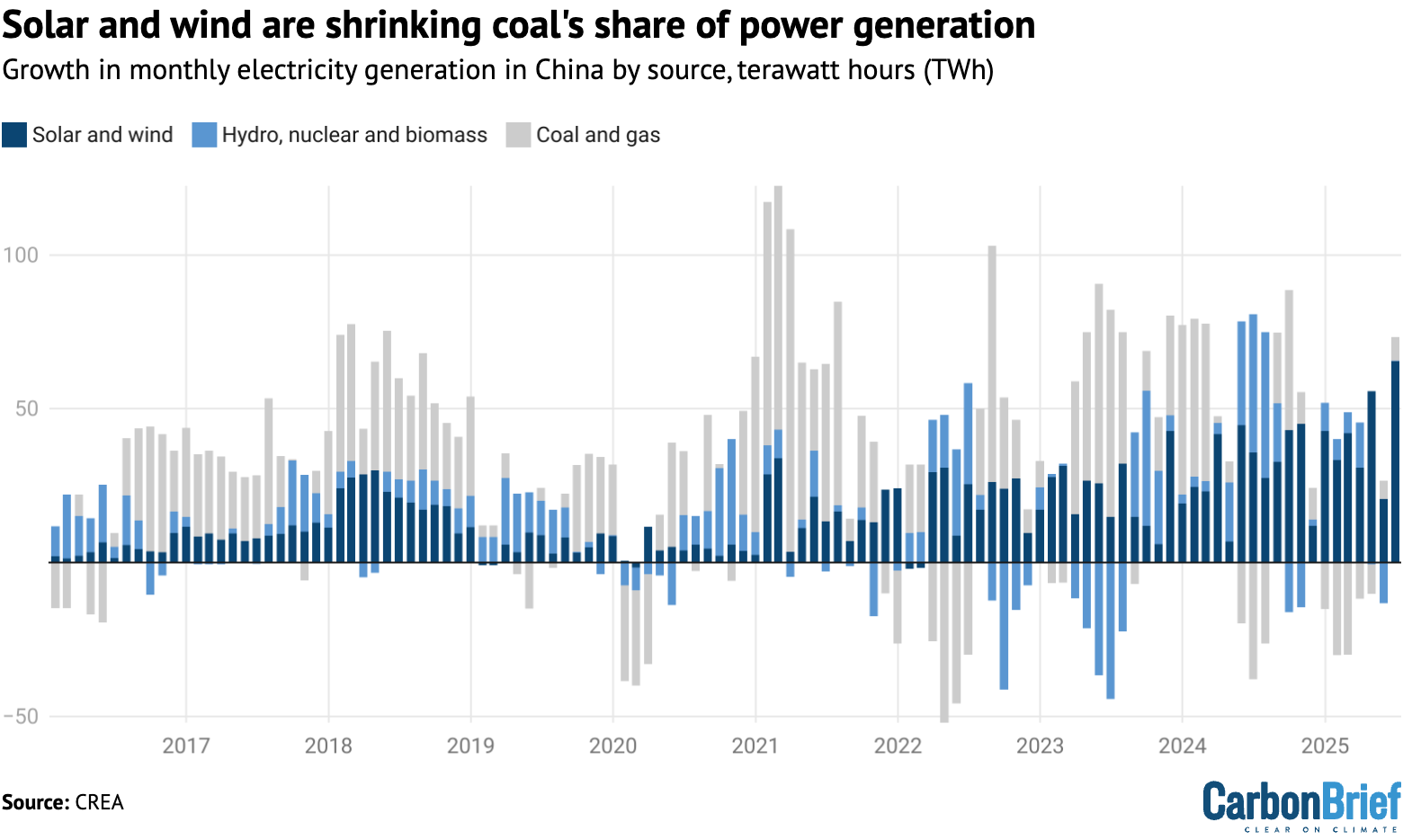
Another way to consider the impact of new coal-fired capacity is to test whether, in reality, it automatically leads to a rise in coal-fired electricity generation.
The top panel in the figure below shows the annual increase in coal power capacity on the horizontal axis, relative to the change in coal-power output on the vertical axis.
For example, in 2023, China added 47GW of new coal capacity and coal power output rose by 3.4TWh. In contrast, only 28GW was added in 2021, yet output still rose by 4.4TWh.
In other words, there is no correlation between the amount of new coal capacity and the change in electricity generation from coal, or the associated emissions, on an annual basis.
Indeed, the lower panel in the figure shows that larger additions of coal capacity are often followed by falling utilisation. This means that adding coal plants tends to mean that the coal fleet overall is simply used less often.
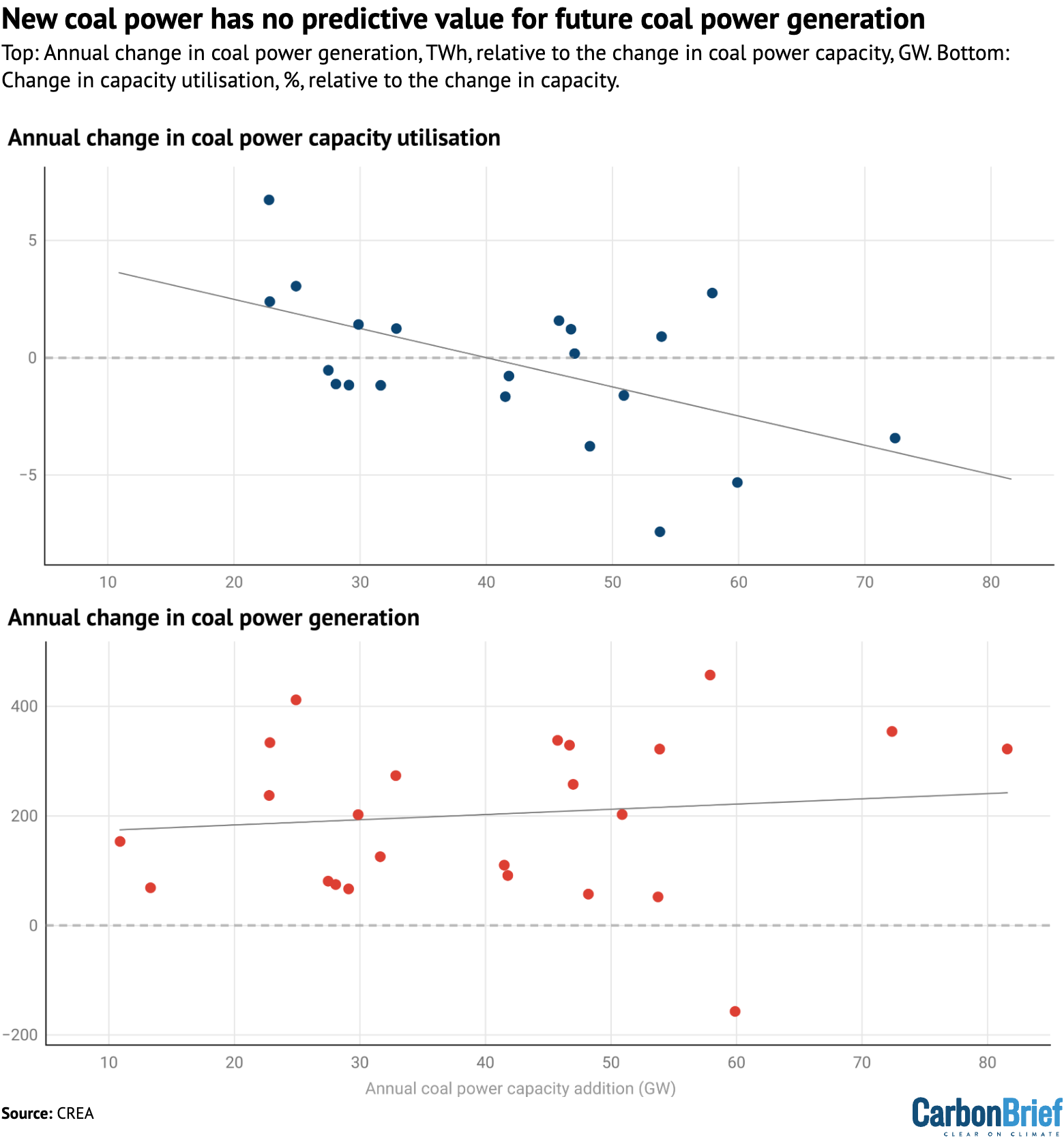
As such, while adding new coal plants might complicate the energy transition and may increase the risk of unnecessary greenhouse gas emissions, an increase in coal use is far from guaranteed.
If instead, clean energy is covering all new demand – as it has been recently – then building new coal plants simply means that the coal fleet will be increasingly underutilised, which poses a threat to plant profitability.
China is not unique in its approach to coal power
The dynamics behind last year’s surge in coal power project construction starts speak to the logic of China’s system, in which cost-efficiency is not always a central concern when ensuring that key problems are solved.
If a combination of three tools – coal power plants, storage and grid flexibility, in this case – can solve a problem more reliably than one alone, then China is likely to deploy all three, even at the risk of overcapacity.
This approach reflects not just a desire for reliability, but also deeper institutional dynamics that help to explain why coal power continues to be built.
But that does not mean that such a pattern is unique to China.
The figure below shows that, across 26 regions, a peak in coal-fired electricity generation (blue lines) almost always comes before coal power capacity (red) starts to decline.
Moreover, the data suggests that once there has been a peak, generation falls much more sharply than capacity, implying that remaining coal plants are kept on the system even as they are used increasingly infrequently.
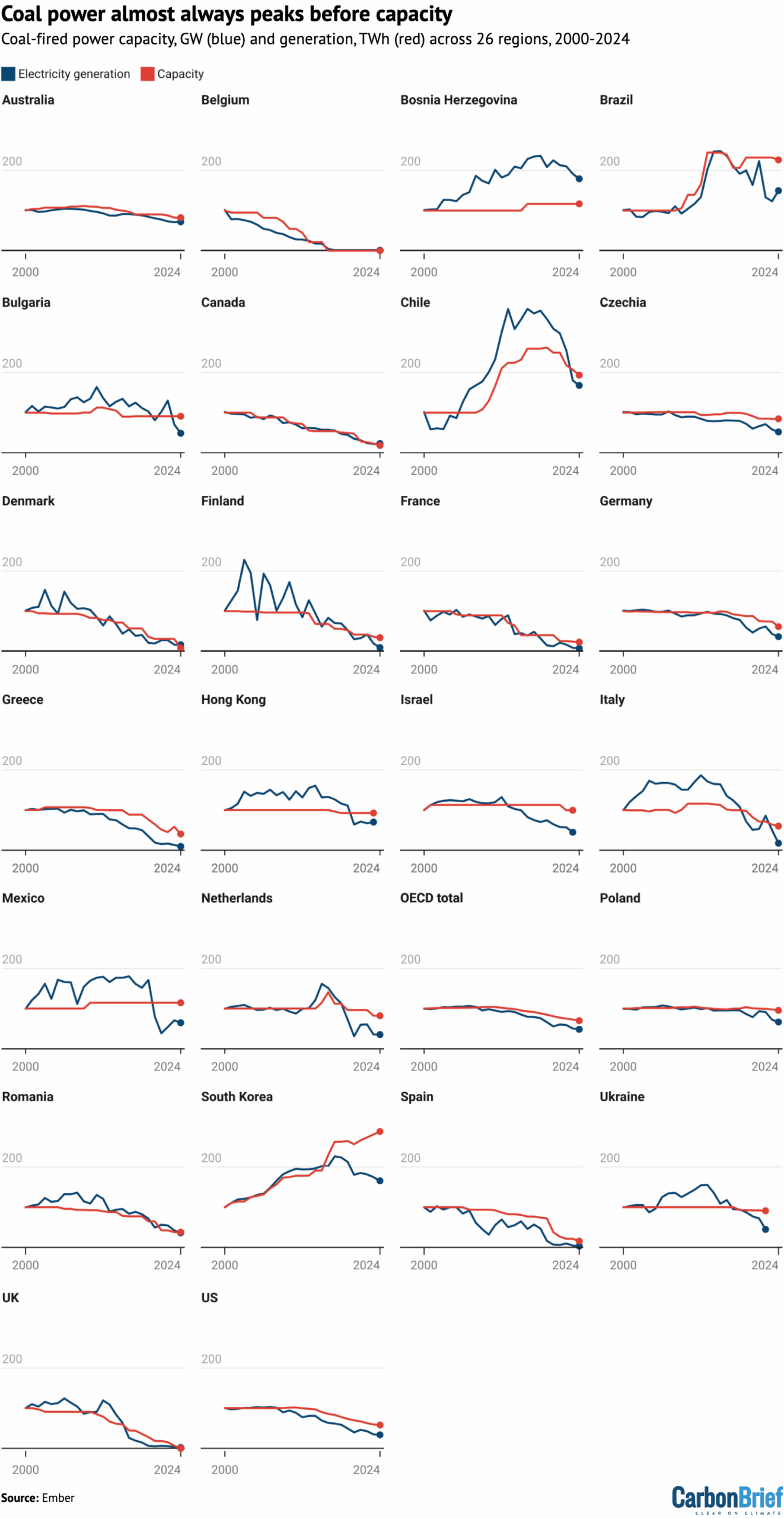
In most cases, what ultimately stopped new coal power projects in those countries was not a formal ban, but the market reality that they were no longer needed once lower-carbon technologies and efficiency gains began to cover demand growth.
Coal phase-out policies have tended to reinforce these shifts, rather than initiating them. In China, the same market signals are emerging: clean energy is now meeting all incremental demand and coal power generation has, as a result, started to decline.
Coal is not yet playing a flexible ‘supporting’ role
Since 2022, China’s energy policy has stated that new coal-power projects should serve a “supporting” or “regulating” role, helping integrate variable renewables and respond to demand fluctuations, rather than operating as always-on “baseload” generators.
More broadly, China’s energy strategy also calls for coal power to gradually shift away from a dominant baseload role toward a more flexible, supporting function.
These shifts have, however, mostly happened on paper. Coal power overall remains dominant in China’s power mix and largely inflexible in how it is dispatched.
The 2022 policy provided local governments with a new rationale for building coal power, but many of the new plants are still designed and operated as inflexible baseload units. Long-term contracts and guaranteed operating hours often support these plants to run frequently, undermining the idea that they are just backups.
Old coal plants also continue to operate under traditional baseload assumptions. Despite policies promoting retrofits to improve flexibility, coal power remains structurally rigid.
Technical limitations, long-term contracts and economic incentives continue to prevent meaningful change. Coal is unlikely to shift into the flexible supporting role that China says it wants without deeper reform to dispatch rules, pricing mechanisms and contract structures.
Despite all this, China is seeing a clear shift away from coal. Clean-energy installations have surged, while power demand growth has moderated.
As a result, coal power’s share in the electricity mix has steadily declined, dropping from around 73% in 2016 to 51% in June 2025. The chart below shows the monthly power generation share of coal (dark grey), gas (light grey), solar and wind (dark blue), and other low-carbon sources (light blue) from 2016 to the present.

When will the coal boom end?
About a decade ago, the end of China’s coal power expansion also looked near. Coal power plant utilisation declined sharply in the mid-2010s as overcapacity worsened. In response, the government began restricting new project approvals in 2016.
With new construction slowing and power demand rebounding, especially during and after the height of the Covid-19 pandemic, utilisation rates recovered. Not long after, power shortages kicked off the recent coal building spree.
Now, there are new signs that the coal power boom is approaching its end. Permitting is becoming more selective again in some regions, especially in eastern provinces where demand growth is slowing and clean energy is surging. Meanwhile, system flexibility is advancing.
Compared to the late 2010s, the current shift appears more structural. It is driven by the rapid expansion of clean energy, which increasingly eliminates the need for large-scale new coal power projects.
Still, the pace of change will depend on how quickly institutions adapt. If grid operators become confident that peak loads can reliably be met with renewables and flexible backup, the rationale for new coal power plants will weaken.
Equally important, entrenched interests at the provincial and corporate levels continue to push for new plants, not just as insurance, but as sources of investment, employment and revenue. Through long-term contracts and utilisation guarantees, this represents institutional lock-in that may delay the shift away from coal.
The next major turning point will come when coal power utilisation rates begin to fall more sharply and persistently. With large amounts of capacity set to come online in the next two years and clean energy steadily displacing coal in the power mix, a sharp drop in coal power plant utilisation appears likely.
Once this happens, the central government might be expected to step in through administrative capacity cuts – forcing the oldest plants to retire – just as it did during overcapacity campaigns in the steel, cement and coal sectors around 2016 and 2017.
In that sense, China’s coal power phase-out may not begin with a single grand policy declaration, but with a familiar pattern of centralised control and managed retrenchment.
A key question is how quickly institutional incentives and grid operation will catch up with the dawning reality of coal being squeezed by renewable growth, as well as whether they will allow clean energy to lead, or continue to be held back by the legacy of coal.
The upcoming 15th five-year plan presents a crucial test of government priorities in this area. If it wants to bring policy back in line with its long-term climate and energy goals, then it could consider including clear, measurable targets for phasing down coal consumption and limiting new capacity, for example.
While China’s coal power construction boom looks, at first glance, like a resurgence,it currently appears more likely to be the final surge before a long downturn. The expansion has added friction and complexity to China’s energy transition, but it has not reversed it.
The post Guest post: Why China is still building new coal – and when it might stop appeared first on Carbon Brief.
Guest post: Why China is still building new coal – and when it might stop
-
Climate Change2 years ago
Spanish-language misinformation on renewable energy spreads online, report shows
-
Climate Change Videos2 years ago
The toxic gas flares fuelling Nigeria’s climate change – BBC News
-

 Greenhouse Gases1 year ago
Greenhouse Gases1 year ago嘉宾来稿:满足中国增长的用电需求 光伏加储能“比新建煤电更实惠”
-

 Climate Change1 year ago
Climate Change1 year ago嘉宾来稿:满足中国增长的用电需求 光伏加储能“比新建煤电更实惠”
-

 Carbon Footprint1 year ago
Carbon Footprint1 year agoUS SEC’s Climate Disclosure Rules Spur Renewed Interest in Carbon Credits
-
Climate Change2 years ago
Why airlines are perfect targets for anti-greenwashing legal action
-
Climate Change Videos2 years ago
The toxic gas flares fuelling Nigeria’s climate change – BBC News
-
Climate Change2 years ago
Some firms unaware of England’s new single-use plastic ban



